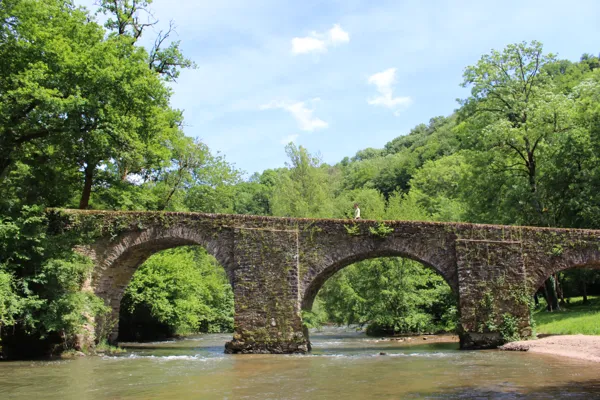Natural sites
in Aveyron
unusual natural sites
The Aveyron has a great diversity of scenery and crossing the département, you are quickly struck by the changing landscape: from the arid land of the Causses du Larzac to the high volcanic plateau of the Aubrac passing via the Rougier de Camarès, you quickly realise that it is a land conducive to impressive natural sites that are unusual at times.
Don’t hesitate! Walk around the “Trou” de Bozouls (Bozouls “hole”), make out the shapes of the rocks at the chaos of Montpellier le Vieux, descend the meanders of the prehistoric caves at Foissac, go for a romantic walk on the Presqu'île de Laussac (Laussac peninsula).

The omnipresent flora
In the south, on the arid land of the Causse du Larzac bathed in the Mediterranean and oceanic climates, both mountain and Mediterranean garrigue scenery are found. Here you will see the symbol of the causse, angels' hair. Will you be able to identify the 45 species of orchids (there are 150 found in France) including the rare Aveyron Ophrys that can be admired but not picked? And what about the magnificent cardabelle golden thistle ?
In the north, on the Aubrac plateaux, the fields wake in spring after having spent several months under snow. Yellow carpets of crocuses and daffodils emerge. Then, the gentians appear that are much appreciated at aperitif time and the Aubrac tea that flavours infusions and liqueurs. Botanical lovers will be won over by more than 2000 plant species to see !
Wild Fauna
A multitude of wild species evolve in complete freedom in the immense woods. Go collecting mushrooms or blackberries and you will see the footprints of foxes, wild boar, deer and hares. Raise your head and perhaps you will glimpse the tail of a red squirrel. What is the impressive bellowing you can hear in early autumn? It’s the deer rutting.
Barn owls, tawny owls, falcons, buzzards or Griffon vultures are just some of the species of birds of prey amongst the 250 that are now found today in the Aveyron.
Along the river banks, herons live alongside coypus. Apparently, even beavers have reappeared on the banks of the river Tarn.

149 results
Les Gorges de la Dourbie
Saint-Jean-du-Bruel
Sentier botanique des Arasses
Villefranche-de-Panat
A family walk takes you on a discovery yourney of the local flora.
Visite du site des Igues du Py et de Rouffiés
Compolibat
This unique phenomenon in Rouergue is caused by erosion and generates natural abysses dug in the red clay, known under the nickname of 'the path of the fairies'.
Oreilles en balade à Villefranche de Rouergue - Balade sonore
Villefranche-de-Rouergue
Grotte préhistorique de Foissac
Foissac
Come and meet the life of prehistoric men in the magical setting of the cave. Unique concretions and prehistoric remains in place.
Point de vue, table d'orientation et tables de pique-nique de "la Croix de Bel" à Goutrens
Goutrens
Between Goutrens and Saint-Christophe.
Tourbière des Founs à Arvieu
Arvieu
Below the Rocher du Diable on the road between Arvieu and Bonneviale. It is a humid area with a very rich (sphagnum, drosera, water clover, cotton grass...) and particularly rare flora. The council has implemented a course of educational and pastoral valuation to enable the curious discovering the value of that natural space.
Table d'orientation du Pic du Pal
Vézins-de-Lévézou
Orientation table with pretty views of the Aveyron valley, the mountains of Aubrac, Cantal...
Aire naturelle de La Roque
La Salvetat-Peyralès
Relax here with the family on the banks of the Viaur between the villages of Bellecombe and La Roque, just south of La Salvetat Peyrales. Just beside the river Viaur, which separates the Aveyron from the Tarn, you'll find all you need here for a relaxing day in the sunshine- picnic tables, barbecues, covered seating area and toilets, all in a beautiful riverside setting. From here you can also follow walk no 9 of the Family Rambles to the chapel at Murat.
Sentier d'observation botanique et écologique du bois de Laguiole
Laguiole
Ce parcours est au départ de la station de ski de Laguiole au Bouyssou. Le parcours fait 9 kms mais il existe 2 raccourcis pour ceux qui ne veulent pas faire la randonnée en totalité.
Monument Talabot
Saint-Geniez-d'Olt-et-d'Aubrac
Point de vue et table d'orientation à Villefranche-de-Rouergue
Villefranche-de-Rouergue
Randonnée Street-Art au cœur de la Forêt
Cransac-les-Thermes
Site de la Plancelle
Campagnac
east of Campagnac the site of la Plancelle provides a spectacular panoramaof the Lot Valley and Aubrac, the villages of Verteilhac and Canilhac in the Lozère.
Cascade de Muret le Château
Muret-le-Château
Serre de Cougouille et sa table d'orientation
Sainte-Eulalie-de-Cernon
to go
further

























